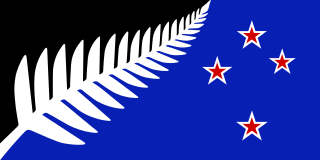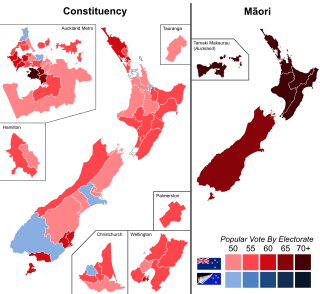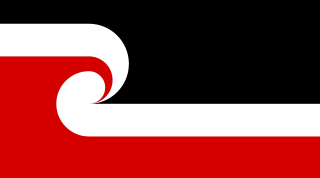
A koru flag was designed by Friedensreich Hundertwasser in 1983 and proposed as a secondary flag for New Zealand. [1]

A koru flag was designed by Friedensreich Hundertwasser in 1983 and proposed as a secondary flag for New Zealand. [1]
As black is a traditional colour of the Māori, the flag has a black strip on the left side. There is a fern green spiral which starts by taking up the entire width of the flag but decreases gradually, splitting it diagonally and finally curling up into a spiral on the right side. This curling fern is based on a Māori pattern known as the koru , and the corresponding white spiral alludes to Aotearoa, a Māori name for New Zealand meaning Land of the Long White Cloud. Hundertwasser also saw the design as representing humanity in harmony with nature.
It is claimed by some New Zealanders that the current flag of New Zealand is a reminder of British colonialism and does not truly represent their culture; however, those who support the current flag say that it represents the history of the country as a part of the British Empire and location in the southern hemisphere.
The flag can be seen on the counter of the convenience store in the 1997 film subUrbia .


A design based on Hundertwasser's flag with the black bar removed was submitted by Tomas Cottle in the 2015–2016 New Zealand flag referendums under the name 'Modern Hundertwasser'. It was initially selected for inclusion in the long list of 40 designs, but was removed due to a copyright claim by the Hundertwasser Foundation. [2]

Friedrich Stowasser, better known by his pseudonym Friedensreich Regentag Dunkelbunt Hundertwasser, was an Austrian visual artist and architect who also worked in the field of environmental protection. He emigrated to the Far North of New Zealand in the 1970s, where he lived and worked for most of the rest of his life.

Air New Zealand Limited is the flag carrier of New Zealand. Based in Auckland, the airline operates scheduled passenger flights to 20 domestic and 30 international destinations in 18 countries, primarily within the Pacific Rim. The airline has been a member of the Star Alliance since 1999.

Tino rangatiratanga is a Māori language term that translates literally to 'highest chieftainship' or 'unqualified chieftainship', but is also translated as "self-determination", "sovereignty" and "absolute sovereignty". The very translation of tino rangatiratanga is important to New Zealand politics, as it is used in the Māori version of the Treaty of Waitangi to express "full exclusive and undisturbed possession" over Māori-owned lands and property, but different translations have drastically different implications for the relationship between the 1840 signatories: the British Crown and the Māori chiefs (rangatira).

The flag of New Zealand, also known as the New Zealand Ensign, is based on the British maritime Blue Ensign – a blue field with the Union Jack in the canton or upper hoist corner – augmented or defaced with four red stars centred within four white stars, representing the Southern Cross constellation.

Alsophila tricolor, synonym Cyathea dealbata, commonly known as the silver fern or silver tree-fern, or as ponga or punga, is a species of medium-sized tree fern, endemic to New Zealand. The fern is usually recognisable by the silver-white colour of the under-surface of mature fronds. It is a symbol commonly associated with the country both overseas and by New Zealanders themselves.

The koru is a spiral shape based on the appearance of a new unfurling silver fern frond. It is an integral symbol in Māori art, carving and tattooing, where it symbolises new life, growth, strength and peace. Its shape "conveys the idea of perpetual movement," while the inner coil "suggests returning to the point of origin".

The coat of arms of New Zealand is the heraldic symbol representing the South Pacific island country of New Zealand. Its design reflects New Zealand's history as a bicultural nation, with a European female figure on one side and a Māori rangatira (chief) on the other. The symbols on the central shield represent New Zealand's trade, agriculture and industry, and a Crown represents New Zealand's status as a constitutional monarchy.

The United Tribes of New Zealand was a confederation of Māori tribes based in the north of the North Island, existing legally from 1835 to 1840. It received diplomatic recognition from the United Kingdom, which shortly thereafter proclaimed the foundation of the Colony of New Zealand upon the signing of the Treaty of Waitangi.

A silver fern flag is any flag design that incorporates a silver fern, and is usually a white silver fern on a black background. The silver fern motif is associated with New Zealand, and a silver fern flag may be used as an unofficial flag of New Zealand, to which it is endemic. The silver fern itself is a quasi-national emblem, being used for various official symbols, including the coat of arms of New Zealand and the New Zealand one dollar coin. A number of New Zealand sports teams, such as the cricket team, the netball team and the rugby union team, use similar silver fern flags as part of their official merchandise. The All Whites, New Zealand's national association football team, use a white background and a black version of the fern.
The New Zealand national korfball team, nicknamed The Korus, is the national team representing New Zealand in korfball international competitions. The team is managed by Korfball New Zealand (KNZI). The name The Korus is one of many national team nicknames (indirectly) related to the All Blacks and/or the New Zealand silver tree fern.

The black, white and blue silver fern flag is a proposed flag for New Zealand by architectural designer Kyle Lockwood. It was first designed using different colours in 2000. It was voted as the preferred alternative New Zealand flag in the first of two New Zealand flag referendums in December 2015, and was used in the second flag referendum in a binding contest against the current New Zealand flag. Despite a UMR poll predicting that the flag would earn only 35% of the vote, the Silver Fern Flag gained a significant minority in the March 2016 referendum with 43.2% of the vote, whilst the existing flag won with 56.6% of the vote.

The New Zealand flag debate is a question over whether the national flag should be changed. For several decades, alternative designs have been proposed, with varying degrees of support. There is no consensus among proponents of changing the flag as to which design should replace the current one. Common criticisms of the existing form of the New Zealand flag are its similarity to the Australian flag and the inappropriateness of retaining the Union Jack in the design. A series of polls conducted since the 1970s have shown that a majority of New Zealanders prefer the current flag.

Ōpōtiki College is a state secondary school located in Ōpōtiki, in the Bay of Plenty, North Island, New Zealand.
The national colours of New Zealand orders include black, white or silver, and red ochre.

The Red Peak flag is a proposed New Zealand flag that appeared as one of five options for voters to consider in the 2015–16 flag referendums. Designed by Aaron Dustin in 2015, Red Peak appeared on the government's official longlist of 40 alternative flag designs before failing a final culling of the field on 1 September 2015 to four options. After public disappointment with the official four-flag shortlist, a social media campaign was launched on 2 September that revived the flag's prospects and captured the attention of leading parliamentary figures both in government and opposition. On 23 September, Prime Minister John Key announced the government had agreed to support Green Party legislation that would add Red Peak to the referendum ballot as a fifth option.

Two referendums were held by the New Zealand Government in November/December 2015 and March 2016 to determine the nation's flag. The voting resulted in the retention of the existing flag of New Zealand.

The national Māori flag, also known as the Tino Rangatiratanga flag in reference to the concept of tino rangatiratanga, is used to represent the Māori people of Aotearoa. In 2009, the Tino Rangatiratanga flag was selected as the national Māori flag after a nationwide consultation. It was first revealed on Waitangi Day in 1990. Though it does not have official status from the New Zealand Government, it has been used by the government on official occasions.

Tyla King is a New Zealand international rugby union player, professional rugby league player and Olympian.

The flag now known as the flag of theUnited Tribes of New Zealand or Te Kara is a flag originally designed by Henry Williams to represent the New Zealand Church Missionary Society. It was adopted as a national flag by a group of rangatira in 1834 and is today more closely associated with the Māori people.